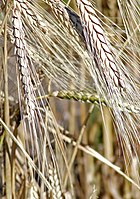
Photo from wikipedia
Abstract Wheat grain represents an important source of bioactive components that are associated with different health benefits, notably: dietary fibers, micronutrients and phytochemicals. However, despite the importance of these components,… Click to show full abstract
Abstract Wheat grain represents an important source of bioactive components that are associated with different health benefits, notably: dietary fibers, micronutrients and phytochemicals. However, despite the importance of these components, limited data are available on their content and composition, especially in durum wheat. In this study, 82 durum wheat landraces from Iran and Mexico were analyzed for arabinoxylan, iron, zinc, phytate and phenolic acids content. In general, wide variation was identified among landraces for these traits. Specifically, values ranging from 1.4 to 2.7% and 0.3–1.0% were detected for total and water-extractable arabinoxylans, respectively, in flour. In the case of micronutrients varied from 32.7 to 46.1 mg/kg (iron) and from 46.7 to 83.9 mg/kg (zinc) in grain. Phytate, a major component limiting micronutrient bioavailability, varied from 0.7 to 1.1% in whole-meal flour and the resulting phytate:iron and phytate:zinc molar ratios were 13.7–26.6 and 11.6–21.9, respectively, with more than 70% of the landraces exhibiting a relatively high Zn bioavailability. Seven phenolic acids were identified, with a variation in total phenolic acid concentration ranging from 279 μg/g to 845 μg/g in whole-meal flour. Overall, these results indicate that the landraces analyzed here could serve as useful genetic resources for the improvement of wheat nutritional quality in breeding programs.
Journal Title: Lwt - Food Science and Technology
Year Published: 2020
Link to full text (if available)
Share on Social Media: Sign Up to like & get
recommendations!